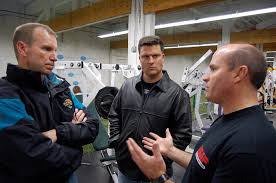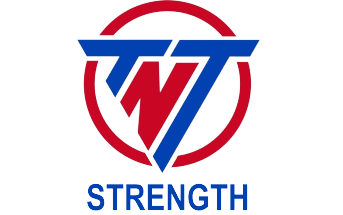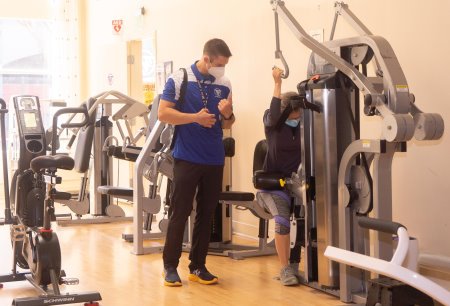
By Mark Asanovich
THE 4-P’s of EVIDENCE-BASED STRENGTH TRAINING & CONDITIONING
PRUDENT
PRODUCTIVE
PRACTICAL
PURPOSEFUL
WHAT IS A PRUDENT STRENGTH TRAINING PROGRAM?
The answer lies in two questions:
1. “Are the training protocols orthopedically-safe?”
2. “Are the training protocols physiologically-sound?”
Obviously, it is the intent of any strength-training program
to ENHANCE the physical potentials of the lifter rather than ENDANGER the lifter.
In other words,use common sense. If an exercise or training technique looks dangerous — it probably is!
An orthopedically safe program has at its foundation the execution of properly performed repetitions. The emphasis should always be on HOW the resistance is lifted rather than HOW MUCH is lifted. Every effort should be made to minimize the bio-mechanical loading (bouncing, recoiling etc.) on muscles, joints and connective tissue, and to maximize muscular tension. Each repetition should be executed under control in a deliberate fashion. Flex the muscle momentarily in the mid-range of the exercise when the muscle is in its “fully contracted position”. Then lower the resistance slowly to the starting position. Obviously, this is the most difficult way to train; however it is also the most productive and prudent way to train.
A physiologically sound strength-training program is one that includes in its design the fundamental principles of training right, eating right, resting right and living right. As simple as it is to understand — it is anything but simple to do. To compromise anyone of these realities would likewise compromise results. There are no “secret”, “short-cut” and/or “simple” means to achieve maximum strength gains. Rather, there is no substitute for progressively highly intense exercise, a nutritious meal plan, ample rest/recovery, and a common sense approach to a consistent training routine.
WHAT IS A PRODUCTIVE STRENGTH TRAINING PROGRAM?
The physiological basis of strength training is the overload principle. This principle requires that a muscle be progressively overloaded beyond its current capabilities to stimulate a strength/growth response. Therefore, any progressive strength training protocol that has a systematic plan of overload (i.e. increasing resistance/repetitions) will produce results! Otherwise stated, despite what strength-training program is used, it is the INTENSE and INTELLIGENT application of the lifter’s EFFORT that is most responsible for their results — not the program. The bottom line is, and always will be, an issue of COMMITMENT and HARD WORK — not how many sets/reps were performed.
Maximal effort is required to develop maximal results. HARD WORK should not be confused with MORE WORK. Truth be told, it does not take a maximal amount of work and/or time to develop maximal results. It does require maximal effort and maximal perseverance. In other words, strength development is USE IT OR LOOSE IT — AND DON’T ABUSE IT! Train hard, chart your progression, allow ample time to rest/recovery between workouts and incorporate variety into your program to prevent over-training and monotony.
WHAT IS A PRACTICAL STRENGTH TRAINING PROGRAM?
As stated, all progressive strength training protocols are PRODUCTIVE – none more significant than the other; however, not all are equally PRACTICAL. Strength can be developed either by exposing the muscle to a lengthy “high volume” of exercise or by brief “high intensity” exercise. Both training protocols have their advantages and disadvantages. However, given the time constraints for most individuals, it is much more practical to decrease the volume of training in favor of increasing the intensity of training to get the same results in less time. In other words, the training goal should be to spend the minimal amount of time to derive the maximal amount of benefits.
WHAT IS A PURPOSEFUL STRENGTH TRAINING PROGRAM?
Strength training is a means to an end — not an end in itself. It is not the goal to develop Olympic Weightlifters, Power-lifters or Bodybuilders. Rather, the goal of strength training is to develop maximal levels of muscular strength to maximize functional capacity.
The development of muscular strength is the general progression of increasing the muscle’s ability to produce force. In other words, strength is a non-specific adaptation developed in the weight room whereas skills are a specific adaptation developed through guided practice. As a result, strength is developed physically in the weight room, which by a separate process is developed mechanically outside the weight room. Simply stated, you build muscle in the weight room and movement outside the weight room.
TAKU’s NOTE:
As I recently stated in our podcast episode #34 featuring Tyler Hobson, The FOUR “P’s” by Mark Asanovich, are principals that every strength coach, and personal trainer, needs to hear. Not only do they need to hear them, but they need to read, understand, and then apply them in the field. We would have far greater levels of success and far fewer silly injuries (not to mention far less time wasted) if more coaches and trainers adopted and implemented these excellent principals.
TNT has over 35 years of combined fitness experience, so if you’re looking for a coach who can train you online from anywhere in the world, visit our online training page to book a consultation.
TNT wants you to maximize your strength as safely and efficiently as possible, so if you’re looking for a stand alone workout plan, check out our Blackjack training program.

















